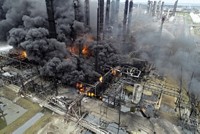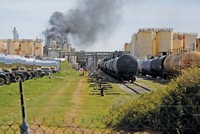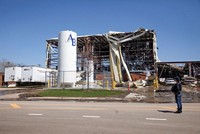Advertisement
Grab your lab coat. Let's get started
Welcome!
Welcome!
Create an account below to get 6 C&EN articles per month, receive newsletters and more - all free.
It seems this is your first time logging in online. Please enter the following information to continue.
As an ACS member you automatically get access to this site. All we need is few more details to create your reading experience.
Not you? Sign in with a different account.
Not you? Sign in with a different account.
ERROR 1
ERROR 1
ERROR 2
ERROR 2
ERROR 2
ERROR 2
ERROR 2
Password and Confirm password must match.
If you have an ACS member number, please enter it here so we can link this account to your membership. (optional)
ERROR 2
ACS values your privacy. By submitting your information, you are gaining access to C&EN and subscribing to our weekly newsletter. We use the information you provide to make your reading experience better, and we will never sell your data to third party members.
Safety
U.S. Chemical Safety Board sued for not creating emissions reporting rule
Regulation proposed in 2009 but dropped because of cost, industry opposition
by Jeff Johnson, special to C&EN
December 18, 2017
| A version of this story appeared in
Volume 95, Issue 49

Several nonprofit organizations sued the U.S. Chemical Safety Board earlier this month for failing to establish a national reporting system to collect data on air pollution emissions from accidents by U.S. companies. The CSB reporting system is required by the Clean Air Act of 1990, which created the board.
CSB is an independent federal agency responsible for investigating industrial, chemically related accidents and determining their root cause. Several hundred accidents annually meet the criteria for CSB investigations—a fatality among workers or the public, serious injuries, or substantial property damage—although the agency only has the resources to investigate a few.
CSB has in the past recognized the importance of the reporting requirement and proposed a regulation in 2009. In that proposal, the board identified a host of improvements that would come from the regulation. It noted, for instance, that timeliness, completeness, and accuracy of chemical incident reports would be improved. Also, required reporting would better help the agency assess issues and trends and further the cause of accident prevention, the proposal said.
But CSB dropped the proposal due to a combination of implementation costs, lack of funding, and industry opposition to new reporting requirements, according to sources familiar with the proposal.
The arguments in the lawsuit pushing for the reporting regulation largely echo those that CSB identified in its proposal. CSB currently tracks incidents using media reports in combination with data collected by the U.S. Coast Guard National Response Center and a mix of other sources of accident information.
Adam Carlesco, a lawyer with Public Employees for Environmental Responsibility, which is leading the litigation, compares that current system to a “news clipping service” and calls it an inadequate safeguard for the health of communities, workers, and first responders.
CSB did not respond to questions. Aside from the suit, the agency has been hammered for more than a decade by reports from the Government Accountability Office and the EPA Office of Inspector General for its failure to comply with the Air Act’s accident reporting provisions.





Join the conversation
Contact the reporter
Submit a Letter to the Editor for publication
Engage with us on Twitter